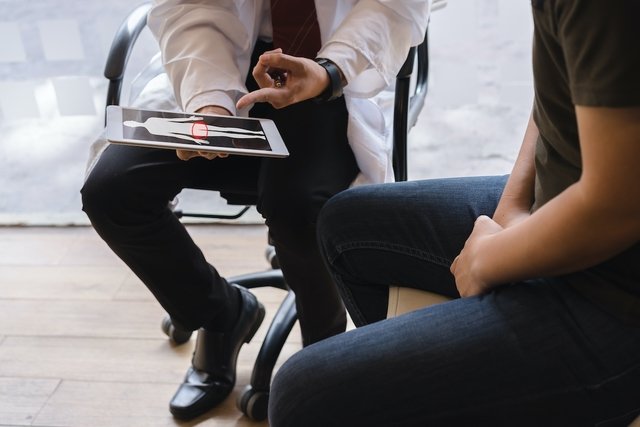Pubalgia is inflammation of the pubic symphysis, which is the place where the two hip bones meet in the front, between the thighs, causing pain in the groin, lower part of the abdomen and/or upper part of the thighs.
Pubalgia, popularly known as groin pain, is more common in people who practice frequent physical activity, especially football or running, but it can also arise due to hip osteoarthritis or inguinal hernia, for example.
It is important that the orthopedist is consulted as soon as the first symptoms of pubalgia appear, as this will enable the diagnosis to be made and the most appropriate treatment initiated, which may include rest, use of medication, physiotherapy exercises or, in some cases, surgery.

Pubalgia symptoms
The main symptoms of pubalgia are:
- Pain in the groin, more specifically in the place where the two hip bones come together, in the front of the body;
- Pain that worsens when standing on one leg;
- Pain in the lower part of the abdomen;
- Burning sensation in the groin area;
- Difficulty or pain walking, running or climbing stairs;
- Weakness in the hip or leg;
- Decreased hip movement;
- Pain in the lumbar region, in the lower back;
- Pain when lying on your side;
- Abdominal pain in the center of the pelvis;
- Pain that may radiate to the upper thighs.
Pubalgia can also cause pain that radiates to the testicles, perineum or genital region, and which worsens when performing physical exercise or during intimate contact.
How to confirm the diagnosis
The diagnosis of pubalgia is made by the orthopedist through the evaluation of symptoms, health history and sports practice, in addition to a physical examination, through palpation of the region and tests such as stretching of the abductors, which are the muscles located in the region. side of the thigh, and resistance to the movement of the adductors, located in the inner region of the thigh.
Taking care of your health has never been easier!
In addition, the doctor may order imaging tests such as ultrasound, X-ray, computed tomography, magnetic resonance imaging or PET-CT of the pelvic region, to confirm the cause of groin pain and initiate the most appropriate treatment.
Possible causes
Pubalgia occurs due to an imbalance or weakening of the muscles on the back and inside of the thigh and the abdominal muscles, causing a change in the joint, injury and inflammation of the bones of the pubic symphysis. Some situations increase the risk of pubalgia, the main ones being:
- Frequent practice of sports, such as football, running or tennis;
- Peripheral neuropathy;
- Inguinal hernia;
- Trauma to the pelvis, such as falls;
- Osteoporosis in the hip;
- Osteoarthritis or osteoarthritis of the hip;
- Cyst in the region of the pubic symphysis, which is the joint at the front of the pelvis.
Furthermore, pubalgia can appear due to pregnancy or after urological or gynecological procedures, for example. Learn about other causes of groin pain.
How the treatment is carried out
The treatment of pubalgia must be carried out under the guidance of an orthopedist, who may recommend resting the joint, using anti-inflammatory medications or physiotherapy, for example, with the aim of relieving pain, reducing swelling in the groin and facilitating movement of the groin. leg and hip. The main treatments for pubalgia include:
1. Rest
In the case of people who constantly practice physical activity, the orthopedist may recommend rest or reduce physical activity to rest the pelvic joint, which helps to relieve pain.
In addition, the doctor may recommend changing sports to low-impact physical activities while the person recovers, such as swimming, for example.
2. Apply cold compresses
Applying cold compresses to the groin, in the region of the pubic symphysis, helps to reduce pain and relieve inflammation in the joint.
To make an ice pack, you must place ice inside a thermal bag or place the gel bag in the freezer to cool, and then wrap the bag or gel bag in a clean, dry towel and apply it to the groin area. , leaving it to act for 15 to 20 minutes, 2 to 3 times a day, for 7 to 10 days.
3. Do physical therapy
Physiotherapy can be recommended by an orthopedist and should be done with the guidance of a physiotherapist, with strengthening and stretching exercises to increase flexibility, improve the stability of the pelvis and hip, and relieve inflammation and pain in the pubic region.
Physiotherapy treatment must be individualized, and generally lasts around 6 to 8 weeks when the pain is recent, but it can take 3 to 9 months when the pain started a long time ago. Normally, during physiotherapy sessions for pubalgia, exercises are done to help strengthen the abdominal and thigh muscles.
4. Taking medicine
The orthopedist can prescribe analgesic and anti-inflammatory medications, such as paracetamol, ibuprofen or naproxen, for example, as they help to reduce pain, relieve swelling and reduce joint inflammation.
These remedies must always be recommended by the doctor and the treatment time must be individualized, according to the intensity of the pain and the improvement of symptoms.
5. Surgery
Surgery for pubalgia is only used in the most serious cases, when physiotherapy treatment was not enough to alleviate symptoms or the person experiences worsening of symptoms, such as increased pain and swelling, as well as difficulty walking or making small movements with the leg.
In these cases, the orthopedist may recommend surgery to make the muscles in the region stronger, which can be performed conventionally or through laparoscopy. After surgery for pubalgia, the doctor must outline a recovery plan so that you can return to sporting activities in approximately 6 to 12 weeks.

Sign up for our newsletter and stay up to date with exclusive news
that can transform your routine!
Warning: Undefined array key "title" in /home/storelat/public_html/wp-content/plugins/link-whisper-premium/templates/frontend/related-posts.php on line 12
Warning: Undefined array key "title_tag" in /home/storelat/public_html/wp-content/plugins/link-whisper-premium/templates/frontend/related-posts.php on line 13



